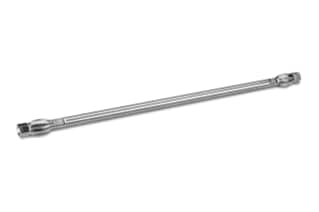
|
Chemistry |
C8 |
|
Separation Mode |
Reversed Phase |
|
Particle Substrate |
Hybrid |
|
pH Range Min |
1 pH |
|
pH Range Max |
12 pH |
|
Maximum Pressure |
6000 psi (415 Bar) |
|
Endcapped |
Yes |
|
Silanol Activity |
Low |
|
Particle Shape |
Spherical |
|
Particle Size |
3.5 µm |
|
Endfitting Type |
Waters |
|
Pore Size |
130 Å |
|
Format |
Column |
|
Surface Area |
185 |
|
System |
HPLC |
|
Particle Technology |
BEH |
|
USP Classification |
L7 |
|
Inner Diameter |
4.6 mm |
|
Length |
250 mm |
|
Carbon Load |
13 % |
|
UNSPSC |
41115709 |
|
Brand |
XBridge |
|
Product Type |
Columns |
|
Units per Package |
1 pk |

XBridge BEH C8 Column, 130Å, 3.5 µm, 4.6 mm X 250 mm, 1/pk
Ethylene Bridged Hybrid (BEH) Particle Technology is the foundation of the XBridge BEH C8 Column. Even in the worst conditions, the BEH technology produces particles that support exceptional column performance and prolonged lifetime. The XBridge BEH C8 Column has been created and developed to provide high efficiency and symmetrical peak shapes, as well as to have exceptional pH stability over a broad pH range.
You can develop techniques at lower speeds in less retentive columns while enhancing overall peak shape and performance because the C8 sorbent in the XBridge BEH C8 Column is less retentive than the XBridge BEH C18 Sorbent. The XBridge BEH C8 Column's tri-functionally bound sorbent offers the widest usable pH range (1–12), excellent low pH stability, and exceptionally little column bleed.
The BEH particle technology contributes to enhanced peak shape by boosting particle strength and lowering the amount of free silanol sites in the injected sample to lessen the likelihood of unfavorable interactions. The overall amount of free silanols decreases with the ethylene bridge, improving the ratio for end capping and attaching the ligand. The XBridge BEH C8 Column will help your lab findings by contributing to their higher peak shape performance.
In order to get the best performance from the analytical column, including enhanced selectivity, lower solvent viscosity, and increased mass transfer rates, it is highly recommended not to go over the limits. Please remember that any increase in the recommended temperature range will cause the column lifetime and performance to decrease. On our website, you may purchase a variety of items, such as guards, vials, and elution plates, that are compatible with the XBridge BEH C8 Column. You can shop for lab equipment from the website, as well as get in touch with us if you have any questions.
Compatible with the XBridge BEH C8 Column, you may also be interested in XBridge BEH C8 VanGuard Cartridge, 130Å, 3.5 µm, 3.9 mm X 5 mm, 3/pk; XBridge BEH C8 VanGuard Cartridges are used to extend analytical column lifetime and performance by removing particulate contamination from the mobile phase stream. This cartridge is optimized to protect all 4.6 mm I.D. XBridge BEH C8 analytical columns containing 3.5 µm sorbent particles.
What Does The Abbreviation HPLC Mean?
High-Performance Liquid Chromatography, or HPLC, is an analytical method for separating, identifying, and quantifying components within a mixture so that you may test and conduct an analysis on them. This test is employed for a number of applications and is the single most often utilized procedure in laboratories worldwide.